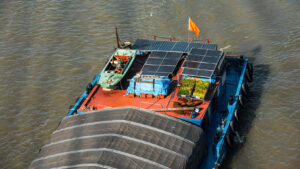At BargeOps, we know firsthand the remarkable potential of waterways in the United States. While the nation’s roads often take the spotlight, the expansive network of over 25,000 miles of navigable intracoastal waterway, including rivers, canals, and coastal routes, remains an unsung hero in American transportation. These waterways are not just vital; they are the lifeblood of efficient cargo movement.
The Unseen Power of Waterways
In the grand scheme of American transportation, waterways remain an untapped treasure trove. Parallel to the importance of roads, these waterways offer a solution that could revolutionize the industry. As Joseph Linck, a renowned international trade and energy consultant, asserts, “We have one of the world’s greatest waterway networks, but we are barely using it.”
A significant component that holds immense promise is the Intracoastal Waterway (ICW), a 3,000-mile inland waterway running from Boston down the Atlantic seaboard, around Florida’s tip, and along the Gulf of Mexico to Brownsville. Linck envisions using this waterway as a solution to the persistent U.S. truck driver shortage, stating that “one barge takes away 70-something trucks off the road and can move freight for less than half the price.”
Read more from Freight Waves: Untapped Potential: Far too little freight on US waterways, experts say
Barges: Unsung Heroes of Transportation
Barges, the workhorses of waterway transportation, possess unparalleled carrying capacity and fuel efficiency. When compared to railcars and trucks, the numbers speak for themselves. A typical 15-barge tow can haul cargo totaling 22,500 tons, 767,500 bushels, or 6.8 million gallons. This dwarfs the capabilities of other modes of transport.
A study by the Center for Ports and Waterways at the Texas A&M Transportation Institute reveals the efficiency of barges. They can move a ton of cargo 647 miles on a single gallon of fuel, and 514 miles on diesel fuel. In contrast, rail achieves 477 miles, while trucks manage only 145 miles per gallon.
The Agricultural Impact
Waterways have long played a pivotal role in American agriculture. The National Grain and Feed Association (NGFA) highlights their significance in transporting grains, including corn, soybeans, wheat, distiller’s dried grains with solubles, and soybean meal. In 2019, nearly 70% of U.S. agriculture exports, valued at $108.2 billion, were waterborne, providing 20% of U.S. farm income.
Urgency for Investment
However, one of the biggest challenges facing U.S. waterways is historical underfunding for essential upkeep, such as dredging and infrastructure maintenance. Aging Army Corps of Engineers infrastructure poses potential risks. Furthermore, escalating traffic at aging locks can bottleneck the system.
The Inner Harbor Navigation Canal Lock (IHNC) in New Orleans exemplifies this issue. Built in 1923, it provides the sole access to the Gulf Intracoastal Waterway east of New Orleans. Replacing it is a top priority for the Gulf Intracoastal Canal Association, as this aging infrastructure is prone to failure.
Embracing a Sustainable Future
Investing in waterway infrastructure isn’t just about enhancing efficiency; it’s also about embracing a sustainable future. Recognizing the intrinsic value of waterways and their environmental benefits, it’s high time we prioritize them as a pivotal piece of America’s transportation puzzle.
At BargeOps, we play a crucial role in ensuring that barge operations run efficiently along these waterways. We understand the potential, the challenges, and the importance of investing in this valuable mode of transportation.
The Gulf Intracoastal Waterway and the broader U.S. waterway system are more than just a transport network; they are the lifeblood of commerce, connecting industries, and sustaining our nation’s economy. It’s time to recognize their enduring impact.
To find out how your barging operation can benefit from this remarkable transportation system, reach out today. Together, we can harness the true potential of these waterways and build a more sustainable and efficient future for American transportation.


